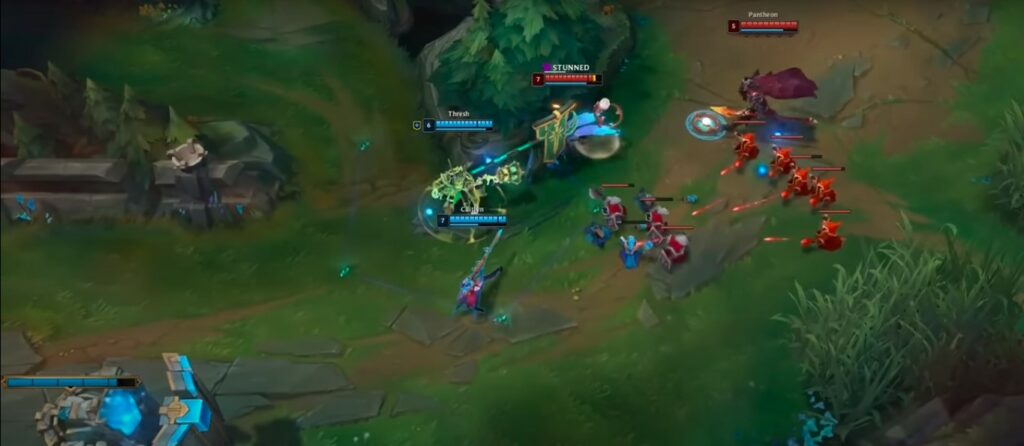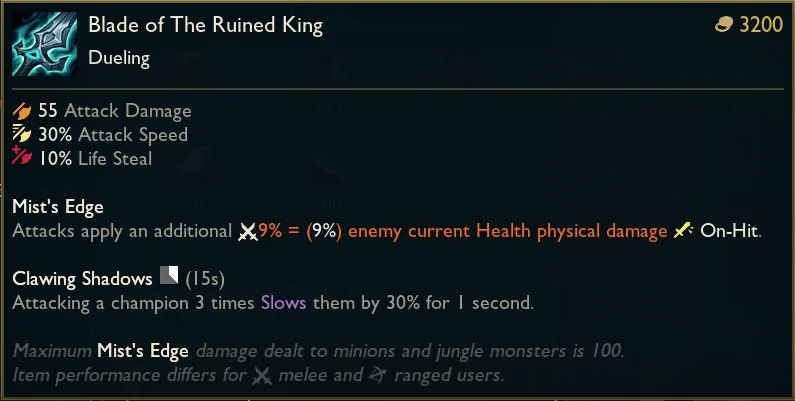- League carries are mostly ranged glass canons, whereas a lot of DOTA carries are melee champions with sufficient survivability.
- Mechanics such as turn rates and a more diverse choice of items and item activities make it easier for melee champions to hold their own in DOTA.
- League discourages melee ADCs by having the laning phase be a lot more aggressive due to champions with constant long range pokes.
Roles in MOBAs can be quite different from one another. Even in the same role, champions can differ greatly from one another. Supports can either be setters that help set opportunities for the team, healers that can provide healing, enhancers that can enhance the team’s damage, tanks, peelers, and debuffs, just to name a few. One role that only has a single established purpose, to deal an absurd amount of damage, is the ADC.
The Range Game
To League fans, an ADC always evokes the image of a ranged carry upon hearing the word. Intentionally putting yourself at a range disadvantage should sound like tilting, but most of the current top DOTA ADCs consist of melee champions. If you’ve ever played against a Teemo top, playing such a match every single game should sound like hell.
Melee Traits
The simplest reason as to why melee carries can hold their own in DOTA is the passive trait that all melee champions carry. This trait’s always active and gives melee champions a flat damage reduction against attacks. This makes them tanky enough to ignore a couple of pokes until they can reach a ranged carry.
Laning

In DOTA, laning is relatively safe. You stay under your turret with a neat little passive buff that aids your defenses. While you can be aggressive, the game plan is normally to farm safely. In League, landing is a lot more aggressive because champions like Brand and Caitlyn are constantly poking you, even under your turret, so their jungle can finish you off with a turret dive.
Kiting
Kiting works differently in the two games. League champions can kite while using their autos because there’s no lag when you turn to face an enemy to attack them and when you face away to run away. DOTA has what’s called turn rates. This makes it so ranged champions can’t just keep attacking you while kiting and running away, as they’re significantly slowed when turning. This gives melee ADCs a chance to get close to them.
Stat Checks

One other difference between the two games is how stats work, and how items affect them. League has a very simple structure: AP buffs your magic damage, AD buffs your physical damage, physical defense and magical defense buff their respective defenses, and crit and attack speed are separate stats.

DOTA presents a different case. You have these more general stats called Strength, Intelligence, and Agility. Each DOTA champion has an innate attribute between the three, and building for said attribute grants bonus base damage. Instead of having a one-to-one relation with stats, these attributes all increase different things.
Gearing
What this different attribute system does is that it makes it possible for champions to build tackiness without sacrificing their damage, something that isn’t possible in League of Legends. You do have certain items that grant both survivability and damage in League, but building them on ADCs is generally not recommended.
In DOTA, if you’re using a Strength carry, building the attribute grants them health, regen, and a bonus to your damage as well. This added survivability, coupled with the innate that reduces damage and higher health pools of melee champions, all make them more viable.
Items Galore!

DOTA has a LOT more items than in League, giving ADCs a wider range of choices. This includes more item passives, yes, but it means that there’s a wider variety of active abilities to choose from. In a game of DOTA, it isn’t uncommon to have 4 different active components of items.
For example, the Diffusal Blade is an item often built by melee carriers. The item provides good stats, as well as a passive that takes mana from the enemy hit to deal bonus damage. The active component of the item is why melee carries all love to build it, being a targetable 100% slow that decays over 4 seconds. This slow, as well as many other items, grants you abilities that are not in the champion’s kit but can help you fill in the gaps where you lack.
Thank you! Please share your positive feedback. 🔋
How could we improve this post? Please Help us. 😔
Heya, I’m Asad (Irre) Kashif! I’ve been writing about anything and everything since as far back as I can remember. Professionally, I started writing five years ago, working both as a ghostwriter and writing under my own name. As a published author and a council member in Orpheus, my journey in the world of writing has been fulfilling and dynamic.
I still cherish the essays I wrote about my favorite PS2 games, and I’m thrilled to have transformed my passion for game journalism into a career. I’m a theory crafter for Genshin Impact (and now Wuthering Waves) and have a deep love for roguelites and roguelikes. While I prefer indie games for their distinct aesthetic and vibes, I do enjoy triple-A games occasionally. I’ve also been playing League since season 6, and I main Akali! I have a keen interest in discovering and playing more obscure games, as well as researching forgotten titles. Additionally, I am a front-end programmer who dabbles a bit in gamedev occasionally.


 Threads
Threads

